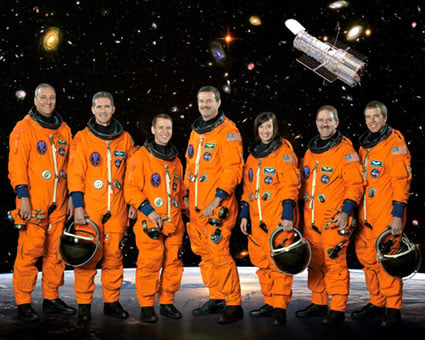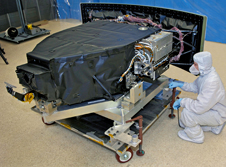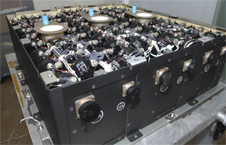Original URL: https://www.theregister.com/2009/03/26/atlantis_roll_out/
Atlantis finally go for Hubble mission
Roll-out to launch pad next week
Posted in Science, 26th March 2009 11:40 GMT
Space shuttle Atlantis will trundle its way to Kennedy Space Center's Launch Pad 39A next Tuesday, in preparation for its much-delayed STS-125 mission to the Hubble Space Telescope.
The vehicle, complete with external fuel tank and twin solid rocket boosters, will travel atop a crawler-transporter for the 3.4 mile journey from the Vehicle Assembly Building to the pad. The trip will take around six hours, NASA estimates.

On board for the 11-day "Servicing Mission Four" - scheduled to blast off on 12 May - are (pictured left to right) mission specialists Michael J Massimino and Michael T Good, pilot Gregory C Johnson, commander Scott D Altman and mission specialists K Megan McArthur, John M Grunsfeld and Andrew J Feustel.
NASA's mission summary explains that this final servicing trip to the space 'scope will "bring new instruments to Hubble along with gyros, batteries and other components crucial for the telescope’s continued success through the year 2013".
Specifically, five spacewalks will see the installation of the new Cosmic Origins Spectrograph and Wide Field Camera 3, plus a refurbished Fine Guidance Sensor which will "replace one degrading unit of three now onboard, and will maintain a robust ability to point the telescope".
 The Cosmic Origins Spectrograph (COS, pictured) will probe the "cosmic web", described by NASA as "the large-scale structure of the universe whose form is determined by the gravity of dark matter and is traced by galaxies and intergalactic gas".
The Cosmic Origins Spectrograph (COS, pictured) will probe the "cosmic web", described by NASA as "the large-scale structure of the universe whose form is determined by the gravity of dark matter and is traced by galaxies and intergalactic gas".
COS will examine how this web "evolved from ancient times", as well as sampling "the chemical content and physical state of gas in distant galaxy halos" to provide an "important insight into the building process of early galaxies and the production of elements heavier than hydrogen and helium over cosmic time".
To accomplish its goals, COS boasts "extraordinary sensitivity" in its far-ultraviolet channel, quantified as "a factor more than 30 times greater than that of previous spectroscopic instruments for the detection of extremely low light levels".
NASA amplifies: "COS has two channels, the Far Ultraviolet (FUV) channel covering wavelengths from 115 to 177 nm, and the Near Ultraviolet (NUV) channel, covering 175-300 nm. Ultraviolet light, the type of radiation that causes sunburn, is more energetic than visible, optical light. 'Near' UV refers to the part of the UV spectrum closer to the visible, just beyond the colour violet.
"The light-sensing detectors of both channels are designed around thin micro-channel plates comprising thousands of tiny curved glass tubes, all aligned in the same direction. Simply described, incoming photons of light ultimately induce showers of electrons to be emitted from the walls of these tubes. The electron showers are accelerated, captured, and counted in electronic circuitry immediately behind the micro-channel plates."
 The Wide Field Camera 3 (WFC3, pictured), meanwhile, will be set to work on "a broad range of inquiry, from early and distant galaxies beyond Hubble’s current reach".
The Wide Field Camera 3 (WFC3, pictured), meanwhile, will be set to work on "a broad range of inquiry, from early and distant galaxies beyond Hubble’s current reach".
The instrument's key feature is its "ability to span the electromagnetic spectrum from the near ultraviolet through the optical ... and into the near infrared". It will be the only Hubble kit with this "panchromatic" talent, NASA explains, and could provide "the greatest era in the spectacular history of Hubble imaging".
NASA elaborates: "The incoming light beam from the Hubble telescope is directed into WFC3 using a pick-off mirror, and is directed to either the Ultraviolet-Visible (UVIS) channel or the Near-Infrared (NIR) channel. The light-sensing detectors in both channels are solid-state devices.
"For the UVIS channel a large format Charge Coupled Device (CCD), similar to those found in digital cameras, is used. In the NIR detector the crystalline photosensitive surface is composed of mercury, cadmium and tellurium (HgCdTe)."
 Rather more mundane items aboard Atlantis will be a new set of six gyros to ensure Hubble's "very precise pointing requirements", two battery modules (pictured) to "rejuvenate the electrical power system" and an "outer blanket layer". The latter, comprising stainless steel sheets, will be installed on the telescope's exterior to "provide additional thermal protection to some equipment bays, replacing the existing multilayer insulation which has slowly degraded over time due to the harsh environment of space".
Rather more mundane items aboard Atlantis will be a new set of six gyros to ensure Hubble's "very precise pointing requirements", two battery modules (pictured) to "rejuvenate the electrical power system" and an "outer blanket layer". The latter, comprising stainless steel sheets, will be installed on the telescope's exterior to "provide additional thermal protection to some equipment bays, replacing the existing multilayer insulation which has slowly degraded over time due to the harsh environment of space".
The Atlantis crew will also carry out repairs to Hubble's Advanced Camera for Surveys and the Space Telescope Imaging Spectrograph. There are full details on all the planned activities available via the main Servicing Mission Four site. ®